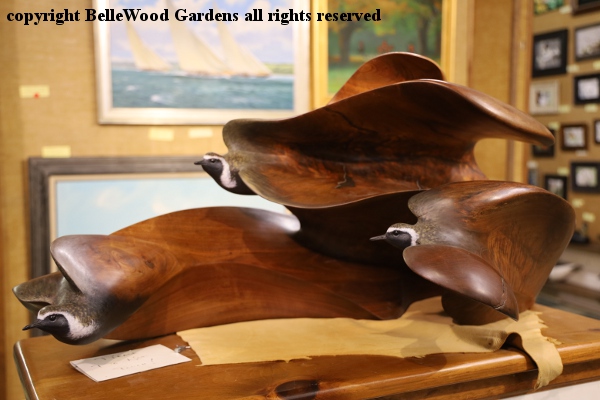
Here's a work by Dave and Mary Ahrendt. Walnut and oil: 37 inches long,
22 inches wide, 19 inches high, it is named Migration of Golden Plovers.
.
If you have any comments, observations, or questions about what you read here, remember you can always Contact Me
All content included on this site such as text, graphics and images is protected by U.S and international copyright law.
The compilation of all content on this site is the exclusive property of the site copyright holder.
Raptors at the Wildlife Art Gallery
Sunday, 23 February 2020
I realized that there is a certain repetition in my entries. BelleWood in Bloom cycles with the seasons, but that is to be expected. However and as an example, every February the New York Botanical Garden has its orchid show. I attend the media preview, create an entry, share with my readers. I decided I must be pro-active about finding new, appropriate, interesting - and enjoyable, let's not forget enjoyable - events to attend and share with you. I was delighted to see that the Decoys and Wildlife Gallery in Frenchtown, New Jersey was hosting a event to benefit the Mercer County, New Jersey Wildlife Center. They would bring some raptors, the gallery would have some food, and even a raffle to benefit the wildlife center. Pencil me in. I'll be there.
A beautiful, sunny, warm-for-February day. The town is filled with tourists, filling up the parking places and strolling up and down the street. I find a place to leave my car, down by the river, and walk to the gallery. Ron Kobli has an inestimable reputation as a source for fine art, decoys and carvings both realistic and artistic. What's the difference?

Here's a work by Dave and Mary Ahrendt. Walnut and oil: 37 inches long,
22 inches wide, 19 inches high, it is named Migration of Golden Plovers.

Compare it with this red tail hawk by Harvey Wilson, wood and
acrylic paint, 35 inches high, 17 inches wide and 14 inches deep.
One is moving, evocative. The other could ruffle its feathers and join the live birds up front.
In fact, let's do just that.
The wildlife center has brought four raptors. These are education birds that for one reason or another can not be released to the wild. They might have been shot or hit by a car and did not heal well enough to survive in the wild. Or, for whatever reason raised by someone who did not quite know how to keep them wild, are imprinted on humans. The bird might fly at a random person, sit on their head, scare the bejesus from whoever was not expecting this, and kill the bird.
These birds are not pets. They have numbers, not names. Fed on rats and mice, bought frozen from vendors, given specialist veterinarian care, they live much longer than they would in the wild where food can be uncertain and injury or disease can be a life or death matter.
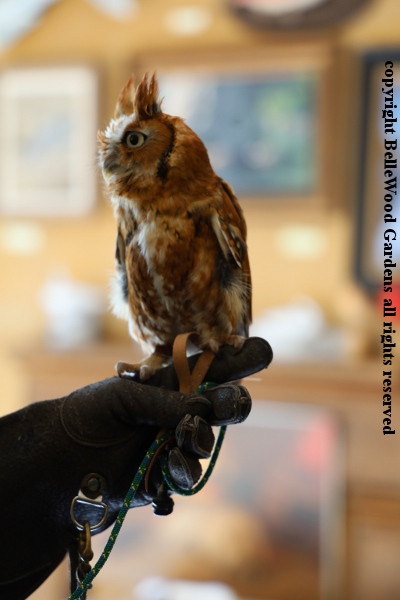 .
.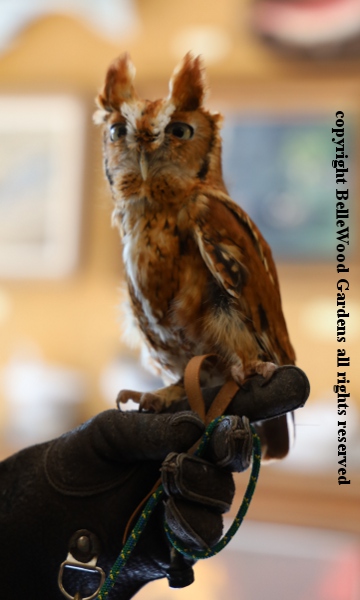
First up is this calm, relaxed little screech owl. One of our smallest native owls it was content to sit quietly on Jane's fist while she answered often repetitive questions from people coming in and wanting to know what does it eat, how old is it, what does it weigh, is it male or female. Female, all four of these raptors are female, and they are larger than the males.
 .
.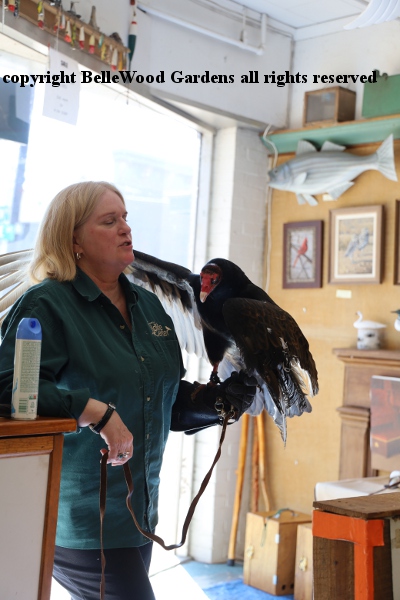
Next was the turkey vulture. She had first been shot and then hit by a car. As you can see, her left wing is badly mangled. She can never fly again. Big as she is, she weighs only 8½ pounds. Birds have hollow bones, you see. Both turkey vultures and the also common black vultures have naked heads and necks. Because they eat carrion, feathers would become fouled with rotting gobbets of flesh. Even 8½ pounds becomes heavy when sitting on your outstretched arm for any length of time. Jane tried resting her hand on a metal support brace but our feathered friend did not like that. Vultures are excellent at catching a thermal and soaring. Takes less effort to float on the rising warm air. So they tend to sleep in until midmorning, when the sun warms the ground, creating lift. The excellent care she receives not only meant her survival, but also her longevity - she's 20+ years old.
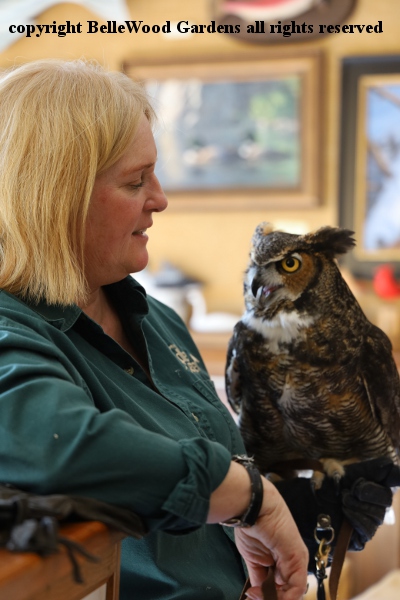
This great horned owl is the one you might hear at night, calling whoo, whoo. She was hit by a car and a fractured bone up near her shoulder healed crookedly so she cannot fly as well as needed for a life in the wild. Weighing only 3½ pounds, in the wild these owls eat mostly mice and rabbits. Their powerful gripping strength of 220 pounds enables great horned owls to successfully take 15 pound prey, including cats and skunks. I must say she did seem interested in small dogs being walking on the street outside the window . . . This elderly bird is 33 years old. In the wild, uninjured, she would have lived perhaps 10 or 15 years. Nocturnal, owls rely more on hearing than eyesight for their hunting prowess. All owls have a flat face which, like a satellite dish, channels sound to their ears. Another excellent adaptation, their feathers have a sort of fringed edge. They fly soundlessly, so the mice, scurrying around at night, have no warning until the owl drops on them from above.
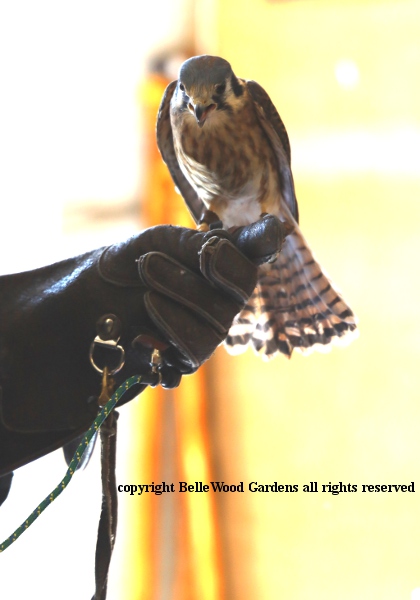 .
.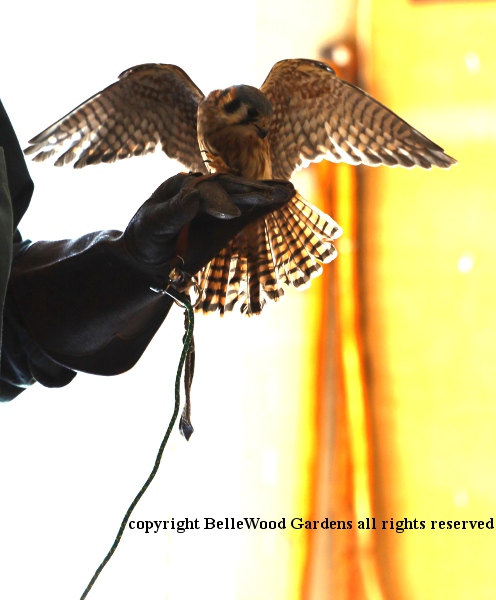
As she opened the carrier Jane warned us to be ready for screeching, and that it wouldn't stop. Right she was. Brought out this handsome little American kestrel, all 120 grams of her. She's imprinted on humans. In the wild they eat grasshoppers, mice, sparrow size birds and other small prey. Kestrels are falcons, not hawks, with the longish, narrow wings typical of falcons.
Wandering through the gallery, admiring carvings, glancing at paintings
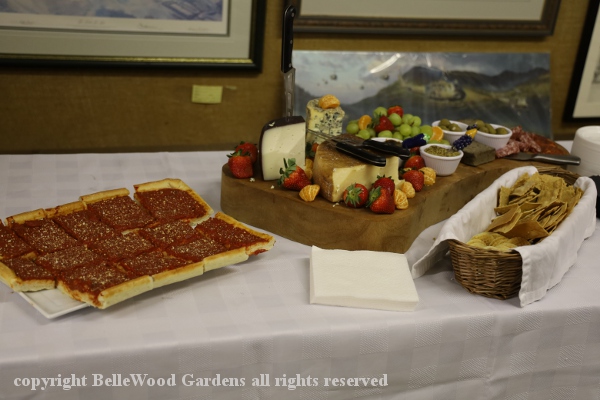
I came upon a table of refreshments. Cheeses, a pate, salami, crackers. Yumm.
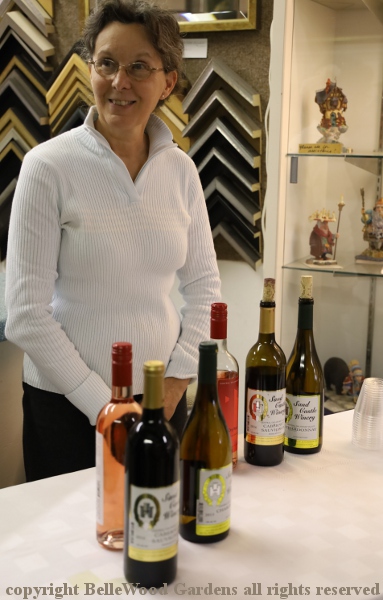
And across the room a table with Sand Castle wines. They're across the river in Pennsylvania. Choices, choices . . . do I want the dryish rose, cabernet savignon, or chardonay. She suggested the red, to pair with the blue cheese I had on my cracker. Indeed, nice. Just like today's event.
Of course, if Ron Kobli hosts this event again next year, why,
I'll just have to add it to my rota of recurring annual events.
Back to Top
Back to February
Back to the main Diary Page